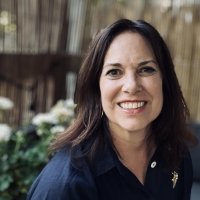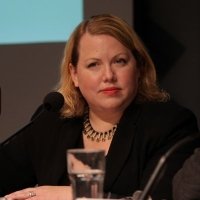The Resilience Beat: Reporting on Climate, Population, and Health
In his 2007 best-seller, The World Without Us, Alan Weisman explored what would happen to the planet if the human race suddenly vanished – the gradual deterioration of the built environment, the geologic fossilization of our everyday stuff, and the ecological processes that would rebound and thrive without continual and growing human pressure.
Researching and writing the book raised a big question. “I want a world with us… Is there a way we can add us back – in harmony with the rest of nature, not in mortal combat?” asked Weisman at the Wilson Center on December 3. So began research for his next book, Countdown: Our Last Best Hope for a Future on Earth?, in which Weisman traveled around the world to explore population-environment dynamics – or what one expert called, “the most important questions on earth.”
Countdown, which won the 2014 Los Angeles Times Book Prize for science writing, argues that one answer is to empower women through education and access to contraception, thus allowing them to make informed choices about their families and their lives.
Weisman was joined by a panel of experienced journalists representing a range of beats and media, but linked by their experiences reporting on the “connective tissue” of current global challenges and the idea of “resilience.”
“Resilience is a term that has many definitions and meanings, but it comes back to a bucket of connected issues – climate change, environment, disaster response, population dynamics, women’s health, human rights, education, and economic development,” said ECSP’s Meaghan Parker.
As interest in these connections grows, how can journalists more effectively cover the promising but challenging stories that fall into the space between traditional beats?
Knowing the Data – and Going Beyond It
To explore the relationship between humans and nature, Weisman’s first step was to better understand population trends. “I needed to know: how did we get so big, and is it really a problem?”
The United Nations Population Division estimates world population grows by nearly 80 million people a year, or 1 million people roughly every 4.5 days. But what does that mean for people’s lives? To find out, Weisman traveled to 21 countries and spoke with scientists, activists, religious leaders, and ordinary men and women. “You’ve heard of a learning curve…for me, this was a learning cliff,” he said.
Alan Weisman speaks to CONTEXT about Countdown: Our Last Best Hope for a Future on Earth?
Weisman focused his investigation on places that exemplified numerous dimensions of population dynamics: Niger, the fastest growing country in the world where women have an average of seven children; Japan, where low fertility has led to population decline; Pakistan, whose persistently high population growth rate means it is poised to become one of the world’s largest countries in coming decades; and Uganda and the Philippines, where innovative programs linking conservation and family planning are part of strategies to preserve biodiversity while meeting a community’s health needs.
Finding the people behind the numbers is critical, Weisman said. “This field is full of terrific characters doing interesting things.” He profiled a Muslim obstetrician-gynecologist in Iran, a devout Catholic Filipino who works with church and government leaders to show how family planning is central to food security, and a former tennis star turned economist in Thailand who has helped de-stigmatize contraception.
Highlighting the Human Connection
Telling these human stories can help convey the complexity behind population-environment connections without losing your audience, said Steve Sapienza, senior producer for the Pulitzer Center on Crisis Reporting. Sapienza helped put together a set of stories about Tonle Sap, Cambodia’s largest freshwater lake, where scientists are developing a complex model that tracks the interactions between natural and human systems to forecast the lake’s future, which is threatened by overfishing, climate change, and hydropower development.
Sapienza and reporter Chris Berdik profiled scientists and local residents as they gathered data in the field. “We wanted to help people understand possible alternate futures for the lake, and we were able to convey that by getting the human stories,” Sapienza said. To bring the story to different audiences, they produced it in a variety of formats, including an eight-minute segment that aired on the PBS NewsHour in June, an article in The New York Times, and a long read with photo slideshow in the Virginia Quarterly Review.
Getting out into the field can help uncover important social and political trends that aren’t apparent on paper, said Jina Moore, global women’s rights reporter for BuzzFeed Newsand former International Reporting Project fellow.
Moore, who is based in Nairobi, explained how she found and pitched a story exploring adramatic decline in maternal mortality in the Republic of Congo (Brazzaville). Local experts attributed the reduction to a recent national policy eliminating fees for Cesarean sections. “I never would have been able to sell my editor on a story about health care infrastructure,” Moore said, but the data on free C-sections was a good hook. By talking with women and health care providers, she was also able to bring to life differences in obstetric care in urban versus rural areas, the significant cultural and logistical challenges in reaching indigenous women, and the links to poverty and social norms around family planning.
Making the Most of the Format
Feature articles, investigative reports, and full-length books provide time and space for journalists to dive deep into the complexities of human-environment interactions, but much of our news is limited to significantly shorter formats. “Conveying information in 10 to 15 seconds is an art form,” said Jennifer Brady, a data analyst for Climate Central’s Climate Matters program, which along with partners at George Mason University, works with a network of 200 television meteorologists in 80 markets to provide clear, concise, science-based climate change information.
Local meteorologists can use “1001 Blistering Future Summers,” Climate Central’s animated map of the United States, to show how hot their city will be in 2100 by taking viewers southward to a city experiencing that temperature today. These simple but effective graphics provide an easy way for local news stations to incorporate climate change information into their broadcasts.
Sapienza also emphasized rising demand for data animation and infographics, citing an innovative visualization comparing the spread of cholera in Haiti to historical cases in New York City and elsewhere. The interactive, embeddable, shareable storytelling map, developed by a journalist with support from the Pulitzer Center, was published in Scientific American and The Huffington Post.
Shedding Light on Solutions
Reporting on resilience, said Parker, requires focusing on the “border points” where issues of science, society, and politics connect.
Lisa Palmer, a freelance environmental journalist and Wilson Center public policy scholar who has written extensively on agriculture, climate change, and food security, found that these connections were difficult to ignore in her work. “I didn’t expect a plant scientist to be talking about the importance of educating women…population and the connection to rights just kept popping up,” she said, leading her to write, “Famine Is a Feminist Issue,” for Slate earlier this year.
“These connections are an important story,” said Weisman. “They help us understand not just what’s going on in the world, but what we can do about it.”
Digging into these questions can get messy, but the outcomes can shed light on a brighter future. “A focus on solutions in journalism forces us to ask important questions: Why is this important? Why now? What is being done, and what is the evidence that it is working?” said Palmer, who is part of the Solutions Journalism Network, a group that supports rigorous, compelling reporting on responses to some of today’s most entrenched social challenges.
In reflecting on his experience writing Countdown, Weisman sees reasons for hope. When given access to family planning and education, people tend to have fewer children than their parents. The challenge is bringing the same level of health care, education, and women’s empowerment to all countries. “The situation,” he said, “is much less dire than I thought.”
Event Resources:
Sources: Al Jazeera, Climate Central, The Economist, My Fox Carolinas, The New York Times, PBS NewsHour, Pulitzer Center on Crisis Reporting, Slate, UN Population Division, Virginia Quarterly Review.
Video Credit: Alan Weisman speaks to the Wilson Center’s CONTEXT program; “Where Your Summer Is Headed,” courtesy of Climate Central.
Speakers

Journalist and Research Professor, George Washington University; Author of Hot, Hungry Planet

Executive Director, Council for the Advancement of Science Writing
Hosted By

Environmental Change and Security Program
The Environmental Change and Security Program (ECSP) explores the connections between environmental change, health, and population dynamics and their links to conflict, human insecurity, and foreign policy. Read more


Brazil Institute
The Brazil Institute—the only country-specific policy institution focused on Brazil in Washington—aims to deepen understanding of Brazil’s complex landscape and strengthen relations between Brazilian and US institutions across all sectors. Read more
